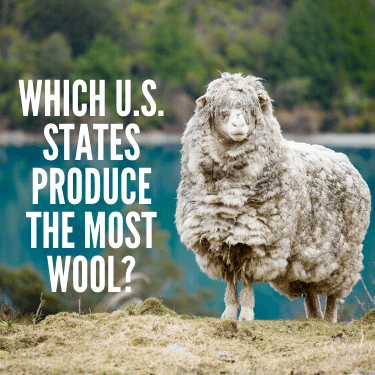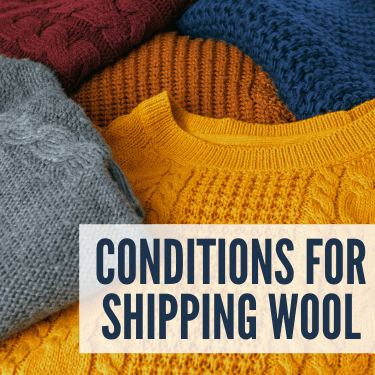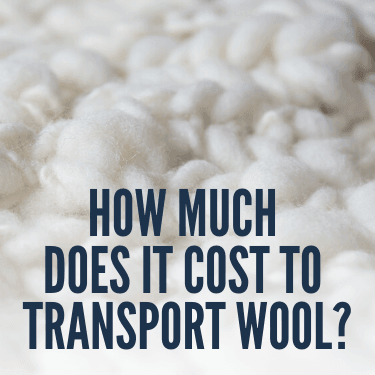While the shearing of sheep’s wool can occur year-round, you only have one shot per sheep a year. So it stands to reason if you’re looking to sell the wool, you also need to know how to ship wool. But what if you’re new to the game and have no idea where to start?
While there is a lot to know about how to ship wool, it’s a lot less of a daunting task once you have the knowledge to do so. Knowing the grade of your wool, the different types and the options and conditions to transport the fabric that you’ve worked hard to help produce. Continue reading for the best tips on how to ship your wool.

Shearing sheep for wool is a time-honored practice throughout the world and also results in an industry worth $45.4 million in 2019 for the United States. That number was up 6 percent from 2018, even as the total number of pounds over the same period of time was down 2 percent.
Like cotton, wool fabrics are made of natural fibers. But while cotton is a plant that is grown, wool comes from the practice of cutting a sheep’s coat of hair and then processing it into wool to be used in a variety of different ways.
The majority of wool production comes from 5 states: Texas, California, Wyoming, Colorado and Utah. What these five states have in common is large areas of land that sheep can be kept on while grazing, which is when livestock eat the grass off fields.
Sending wool from the Beehive State to the Lone Star State? Learn about freight shipping from Utah to Texas. What about south from the Centennial State to the Lone State State? Learn about freight shipping from Colorado to Texas.
The five states listed also spend an ample amount of time between the sheep’s preferred temperatures of 45 to 70 degrees. Anything below or above this can distress the sheep and eventually lead to death.
In America, roughly half of the sheep are of the Rambouillet variety. This sheep embodies several characteristics that make it a desirable breed that do well in the western U.S.
All wool is not created equal, which is to say that there are many different varieties — each with their own characteristics. Some breeds of sheep are not known for producing high-quality wool while others are.
Some of the more notable types of different wool come from these breeds:
In the United States, the Rambouillet serves as the most common type of sheep. This is especially true in western America for a few reasons. The first is their hardiness in arid and semi-arid environments. The Rambouillet also has a strong flocking instinct and can live for 10-12 years. It is a fine wool sheep, which means the wool fibers have a fiber diameter measured at 20 microns (a micron is one-millionth of a meter) or less.
To give a real-world comparison, one human hair averages a width of 100 microns. The measurement of 20 microns or less for wool denotes a finer and softer wool than those that are thicker. Therefore, these are more prized for being made into clothing because wool woven into a sweater will be more comfortable and, crucially, less itchy.
As far as sheep wool goes, merino wool is considered the finest. Merino sheep are raised in Australia and are related to Rambouillet sheep.
Much less prevalent in the United States is Angora wool, from the Angora bunny. This wool is extremely soft and coveted, and also does not cause the same type of allergic reactions as the wool of other animals might.
There is also mohair (from the Angora goat), cashmere (which comes from Cashmere and Pashmina goats). Wool can be spun out of camel and alpaca hair as well, but like cashmere and Angora wool, there is not much of this production in the U.S.

The most common items associated with wool are clothing. When hanks of yarn are made into wool, they do a great job of retaining heat to keep the wearer warm and are pretty durable overall. Outerwear is usually made from more coarse wool, which makes it even stronger than clothing made from finer wool. However, the thicker fibers are more likely to be itchy when brushing against the skin.
Besides clothing, wool is fashioned into other home goods as well. Carpets, rugs, blankets, furniture upholstery and even insulation all utilize wool. As a material, wool is considered more environmentally friendly than synthetic fibers.
Firefighters also use uniforms made out of wool for a very important reason: the fabric is flame retardant up to nearly 1,400 degrees fahrenheit. While other materials can stick, shrink or melt to a person’s skin when exposed to high temperatures, wool doesn’t.
Other less common uses for wool are as yarn between a baseball’s core and outer leather cover. The wool yarn is used because it holds up well to the violent collision of a wood bat meeting a hard-thrown pitch. Wool can also be used as an environmentally safe alternative gardening accessory to rubber mulch. Unlike rubber mulch, wool is biodegradable, has no odor and is absorbent. Furthermore, because of its heat resistance, it won’t catch on fire like rubber mulch can.
Wool is also a product that has little waste, because even its by-product — lanolin — can be used to make shampoos, adhesive tape, auto lubrication and cosmetics.
In the United States, the wool grading system actually refers to three different systems that are used to determine wool grades. Those systems are:
These systems are actually used interchangeably in America, but the micron system is used in other parts of the world, and among buyers and manufacturers of wool. For some perspective, let’s look at the three systems with its lowest and highest grades.
In the American Blood System, the highest quality is graded Fine while the lowest quality is Braid. In the Spinning Count System, anywhere from 64s to over 80s is considered the best while the lowest end is 36s or lower. Lastly, the Micron System sees anything 22 microns or below as the best wool while anything 38.1 microns or higher is considered the coarsest that would go to market.
Although not part of the official grading system, it’s important to make the distinction between virgin wool and wool. Virgin wool refers to the first shearing of a lamb, which can be exceedingly soft and fine. Virgin wool is also finite and carries a higher cost for customers, so that’s why there is still going to be a huge market for normal sheep wool. Virgin wool can also be used as a term in reference to any wool that’s not been processed whatsoever in comparison to wool that’s been woven in any way.
Packaging your wool for shipping is not difficult but is still an important part of the process that shouldn’t be taken lightly. Wool is naturally a resilient material, so the heavy lifting will actually come before it is stuffed into bales.
Before it is packaged, wool needs to be moved from the place the sheep were sheared to a warehouse. The wool, once in the warehouse, are organized into groups of the same quality. At this point, the wool should be looked over to make sure there is no debris of any kind in it. This could be dirt, vegetation or even feces.
Once the wool is clean, it is placed in bales and placed in storage until it has a buyer. From there it will be shipped to the buyer’s processing plant. When packaging the wool to ship to the buyer, you want to compress the wool (but not too tightly) since wool is light and it will spring back to its original space. Bales should be covered to keep the wool inside and allow you to pack more into a single bale.

Like anything, wool is susceptible to being damaged and sustaining product loss if the conditions that it’s shipped within are not carefully considered. First, the temperature needs to be between a certain range to be considered favorable conditions for shipping wool.
That range is from about 41 to 77 degrees fahrenheit (5 to 25 degrees celsius). Along with the actual temperature is the relative humidity of the air surrounding the wool. The ideal percentage is 65 for wool to be shipped or stored at. The third thing to mind is the water content of the wool. It needs to be between 12 and 17 percent.
Wool is super absorbent and can absorb water vapor in the air up to 40 percent without even feeling damp. Measurements for the temperature, humidity and water content can all be monitored using tools.
If wool is being shipped in the height of the summer through very humid states, it could be a good idea to use a climate-controlled truck for those loads. An established third-party logistics (3PL) company has access to vehicles that can be set at the temperature and humidity levels you need so that the chances of losing wool are vastly reduced.
Ventilation is another consideration. If the wool is loaded dry, ventilation shouldn’t be much of an issue. However, if the wool were to be loaded and either it or the conditions surrounding it are damp, then that could be problematic because it would invite mold or bacteria.
Wool isn’t without some risks while shipping it that must be mitigated in order to not have it be damaged before it reaches its destination. Depending on if it’s being shipped as greasy wool or scoured wool, there will be a difference in the things you have to watch out for that can negatively affect your shipment.
First of all, you shouldn’t pack any wool too tightly inside the bales, because the temperature will rise and could cause the wool fibers to become damaged. In fact, the internet heat of wool — if not properly monitored — can cause it to spontaneously combust.
If a fire ever did break out during your wool shipment, the first inclination might be to douse the flames with water. While that would be the right thing to do in most cases, not with wool. The material greatly swells when saturated with water and could cause additional damage. A fire extinguisher using CO2 is preferred because it will not cause the wool to swell up.
This goes doubly for wool shipped still greased. This wool, which still contains a copious amount of both natural grease and keratin, makes it even more likely to be affected by heat. For this reason, smoking is absolutely prohibited around greased wool, which also needs to be kept away from any heat source.
Moisture and excessive humidity are also enemies of wool. Moisture will attract mold and bacteria to wool, which will cause adverse reactions including discoloration and making the wool less durable. Humidity will destroy the outside fiber of the wool strands while giving it a yellowish hue and making the material much more susceptible to tearing.
Water damage in general is a huge concern. The key in limiting the effects of water on your wool shipment is to keep it cool, dry and possibly well-ventilated.

Wool is a commodity that can be shipped quite easily. While the precautions outlined in the previous section outline some of the dangers that can come from shipping wool, if those precautions are taken seriously, wool itself is not fragile.
There are no set prices for the transportation of wool since each load is unique. However, we can look at the five modes of transportation that would be options to use and rank them from most to least expensive:
Wool is able to be transported by air, sea, rail and truck, as touched upon in the previous section. Of the four modes of transportation, the one that could easily damage the wool if proper steps aren’t taken is shipping by sea.
The wool needs to be packaged in a way where the salty humidity of the ocean air can’t find its way into the wool, because it will have to be thoroughly washed in a timely manner to prevent the salt and moisture from damaging the shipment.
Sea transport is very reasonably priced and can reach ports around the world. But along with the aforementioned damage that can come from ocean air, this mode of transport will be painfully slow compared to a plane, truck or train.
Air transit for wool is prized for its quickness and easily controlled climate but is easily the most costly way to ship wool and also unnecessary, especially for domestic shipments. For wool, this method of freight shipping should probably be used sparingly if at all.
Rail shipping is a good shipping method if you’re covering long distances and it is more environmentally friendly than comparable modes of transportation. However, over shorter distances, a truck would be faster and it’s good to keep in mind that a train can’t ship from point A to point B without using a truck at some point.
In fact, it would be highly unlikely for a plane or train to be able to go directly to the retailer and impossible for a ship. So while shipping in the U.S., transport by truck is going to be the best all-around option for shipping wool to retailers.
Now that you know how to ship wool, you should do so with R+L Global Logistics. We are experts at transporting all kinds of commodities for customers, including sheep wool that will be turned into a nice fleece or blanket. We have the resources and experience to help your wool reach more people than ever.
Time is money. To that end, you should be able to see that phrase translated by our 99.5 percent on-time delivery rate. Making sure your shipment is there at the agree-upon time is one of our main priorities. To go with that is our friendly and helpful customer service, an area that we are industry leaders in. It’s your products and your business in our trucks, so we take any questions or concerns you might have along the journey very seriously.
We offer additional services as well, one of which is expedited shipping. While this type of shipping does carry an additional charge, it can cut up to 2 days off transit time and be used as a one-time option when you’re under a time crunch.
When you’re confident that you know how to ship wool, find out the R+L Global Logistics difference by giving us a call at 866.353.7178. You can call for a free quote today and learn exactly what value we can add to your business.
R+L Global Logistics
315 NE 14th St., Ocala, FL 34470